3. Which material for a transport airplane structures ?
3.1 Which forces act on a flying airplane?
Wing
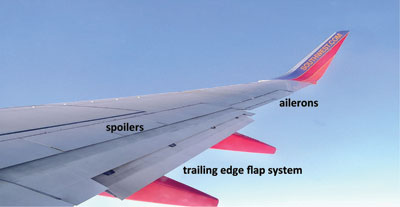
Airplane wing and some of its components
The main function of an airplane wing is to develop lift. The lift is the result of elementary forces due to pressure change on the wing generated in its motion through the air. Lift has to be adequate for all flight conditions. For the take off and landing phase an aircraft utilizes leading and trailing edge flaps (camber and surface effect ). In many airplanes the wing often stores fuel. Moreover the wing develops a large part of drag. So the wing has to withstand to global and local forces: aerodynamic forces, weight and inertial forces in accelerated motion.
Fuselage
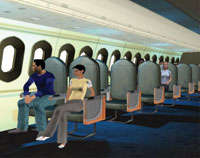
A draft view of an airplane cabin
The fuselage contains people and/or goods in the cabin and pilots in the cockpit. For pressurized fuselage, structures have to withstand the external and internal pressure difference (at 10000m altitude the atmospheric pressure is about 1/3 of the pressure at see level). Moreover the fuselage has to withstand global and local forces as aerodynamic forces, weight and inertial forces, impact on the ground forces, generated by itself or transferred by other parts of the aircraft. The fuselage has to assure the liveability and the comfort of passengers and crew.
Empennage
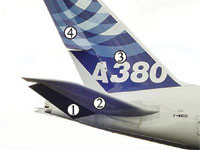
The tail of a very famous airplane
At the back of an airplane there is the horizontal tail, with a fixed part (stabilizer: 2) and a mobile part (elevator: 1) and a vertical tail, with a fixed part (fin: 3) ) and a mobile part (rudder: 4). The fixed part with the mobile part, in fixed condition) are utilized for motion stability. The mobile parts (elevator and rudder) together with aileron on the wing are utilized to control, to maintain or change airplane angular position about its centre of gravity.
Propulsion system
The propulsion system (propulsion devices: propeller or nozzle and engines) transforms energy and generates the thrust or traction to maintain the adequate speed or accelerate to necessary speed of the airplane in any phase of the flight.
An airplane flying in a straight line motion are acting (for simplification we assume an horizontal flight) are:
- pressure forces (Lift and Drag due to pressure), for which each elementary force is perpendicular to the external airplane surface
- tangential forces (friction Drag), for which each element is parallel to the external airplane surface
- Force proportional to mass (Weight and Inertial Force)
- Propulsive forces
An airplane flying in curved line motion are acting, besides the above forces also : inertial forces (centrifugal forces).
The forces proportional to the external surface (pressure and tangential forces, that is the aerodynamics forces have as resultant a global force applied at a point called Aerodynamic Centre (AC) and a force moment a straight like passing through that point.
The forces proportional to the mass have a resultant at the Centre of Gravity (CG) and a force moment-about a straight line passing through that point.
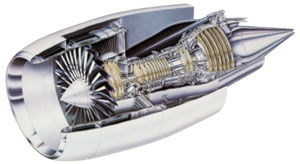
A today airplane turbofan engine
The propulsion system produces the propulsion force (traction or thrust): propeller or nozzle for the airplanes; the engine transforms energy to generates the propulsive forces.
On the upper airfoil surface we have less air pressure than on the lower airfoil surface. The air pressure difference between upper and lower surfaces generates a local aerodynamic force Lp perpendicular to airflow velocity. The Lift on a half wing is the resultant of local aerodynamic wing spanwise forces.
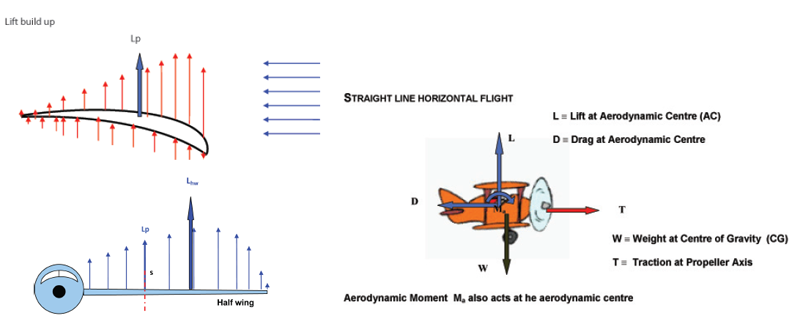
Lift generation
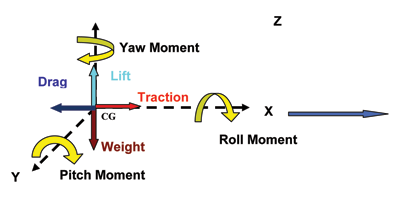
Airplane speed in stationary atmosphere
If we consider tri-rectangular axis system XYZ with the origin at Center of Gravity , the axis XZ in the symmetry plane of the aircraft, assumed as a rigid body, all the above forces can be broken up in Lift ( along Z axis ), Aerodynamic Lateral Force ( along Y axis ), Drag (along X axis), Weight + Inertial Forces ( along Z axis, but opposite to Lift, ), Propulsion Force ( along Xaxis but opposite to Drag ) and three force moments: Pitch Moment (above Y axis), Roll Moment (above X axis ) and Yaw Moment (above Z axis ). In a correct straight flight all Force Moment are equal to zero, and this is gotten by mobile surfaces (elevator , rudder and ailerons). If we want to change flight parameters the mobile surfaces (called control l surfaces) have to be deflected.
All forces and moment acting on a rigid airplane are reduced to three forces and three force-moments applied at Centre of Gravity. How solid, liquid and gases withstand loads? The set of all forces acting considered from the point of view of structural resistance are called < Loads >.
How solid, liquid and gases withstand loads?
The set of all forces acting considered from the point of view of structural resistance are called ‹ Loads ›.
If we consider part of all these forces and moments acting on a single structural element (for simplicity we consider a beam like element), this element can be pulled up (traction), pushed down (compression), sheared (shear force), bended (bending moment) and twisted (torque moment). The structural element will deform itself until the elastic reaction (internal forces) balance the loads.
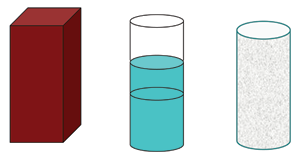
Global behaviour of solids, liquids and gases
There is however a limit to structural capability of withstanding loads. This limit depends on the material properties, the geometry and the way loads are applied. So you can have limits for maximum static loads, for structural instability, for aero-elastic problems and for cyclic application of loads (fatigue).
How many loads are in bow and arrow !
The arch is bended and sheared first by the bowstring and even more by the muscular force of the man.
The bowstring is subjected to traction load. On the arrow the bowstring exercise a compression load and the arm of the man is subjected to traction load and soon.
By experience we know that liquids and gases can withstand only compression loads, solids instead can withstand any kind of loads. This is because the differences internal constitution of solid, liquid and gas materials. So an airplane structure must have the characteristics of a solid.
Solids

Solids
The general behaviour of solids depends on the internal structures of the material: the particles( atoms/molecules)/ molecules are in fixed positions. The particles can vibrate around the fixed position.The amount of kinetic energy of all particles is the heat, the mean kinetic energy is just the temperature. (Simple Kinetic Theory of Heat and temperature)
Liquids
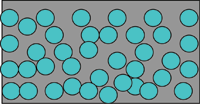
Liquids
The particles of a liquid (atoms or molecules ) have a mean distance of the magnitude of the same diameter of particle diameter. The Particles translate each to respect the others and rotate about a generic axis. Heat and temperatures have the same definition as for gas in the simple Kinetic Theory of Heat and temperature). Because of its mobility their weight tends to push them to full up the lower free space.
Gases
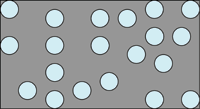
Gases
The mean distance between particles is much greater than a particle diameter. The particle free path is very great and velocity is very high. The particle collisions push the gas to fill up the container and so the gas assumes the same form of the container. The particle collisions against the container walls is the < thermodynamic pressure >.
Note: There is a physical difference between static pressure and thermodynamic pressure for gases !









